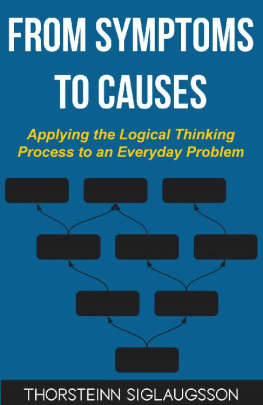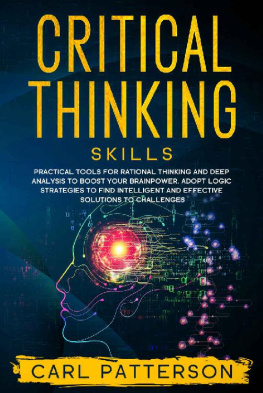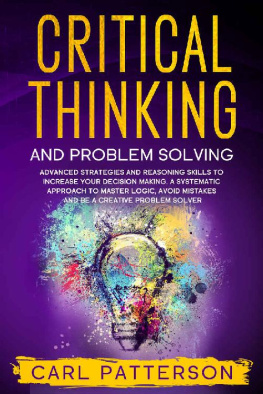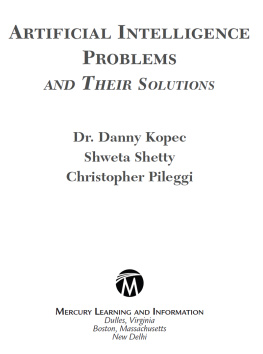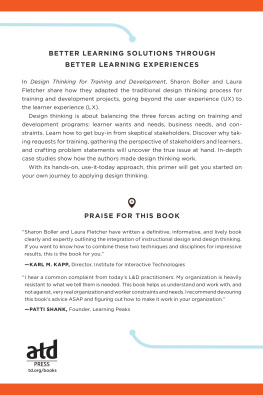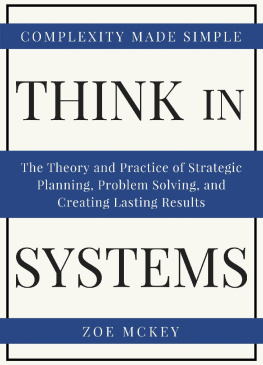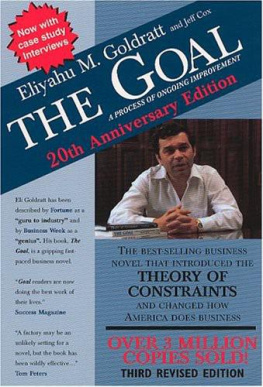Contents
From Symptoms to Causes
Applying the Logical Thinking Process to an Everyday Problem
Thorsteinn Siglaugsson
Copyright 2020 by Thorsteinn Siglaugsson
All rights reserved.
No part of this book may be reproduced in any form or by any electronic or mechanical means, including information storage and retrieval systems, without written permission from the author, except for the use of brief quotations in a book review.
Preface
In 2018 I attended a training course in Paris that fundamentally changed my perspective. This was H. William (Bill) Dettmers six-day course in the Logical Thinking Process, an exceptionally powerful methodology for strategy definition and problem solving, based on the methods of Dr. Eli Goldratt, author of The Goal and systems management legend, adapted and refined by Bill Dettmer.
Towards the end of the course I realized how mastering this rigorous methodology changes the way you approach situations of any kind. It helps you deal with difficult situations in a way few if any other methodologies can.
The purpose of this book is to demonstrate, by means of an everyday example, what the Logical Thinking Process is and how powerful it is when it comes to problem solving, as well as provide a short overview of the theoretical foundations it is based on.
This book is not at all meant to be a comprehensive guide for using the process. It is a primer - but hopefully quite useful as such. Even if it may look simple at first sight, the Logical Thinking Process is a demanding methodology and it takes rigorous training and a good deal of practice to master it. For those interested in learning more about its application I include a short reading list towards the end of the book.
Introduction
The Logical Thinking Process - A game-changer
The Logical Thinking Process is a framework based on the Theory of Constraints Thinking Processes, originally developed by Dr. Eliyahu M. Goldratt, author of bestselling business novel The Goal and pioneer of modern production and process management, as a method to improve decision making in the corporate environment. The purpose of Goldratt's framework is to help people make better use of deductive logic to analyze complicated situations and formulate strategy.
Later enhanced, renamed and refined by H. William Dettmer, author of The Logical Thinking Process A Systems Approach to Complex Problem Solving , the key book on the subject, the Logical Thinking Process is a set of five tools that lead you from defining the goal of your organization or project to mapping the way toward the future. What distinguishes the Logical Thinking Process from most problem-solving and strategy formulation methodologies is its focus on rigorous cause-effect analysis, based on sufficiency and necessity logic, at all stages of the analysis. This is where the alternatives are usually lacking, probably one of the main reasons such a large number of strategy projects eventually fail [1] .
But why would someone want to learn how to think logically? We are all able to do so, are we not? In fact, that is mostly true. Most of us can draw correct conclusions from the facts presented to us, identify the fallacy in a simple, wrong, if-then statement, or build a sound deduction from valid assumptions.
However, most of us can do this only to a certain extent, that is, as long as the situation is not too complicated. But in reality, situations very often are.
I recently watched a documentary about Magnus Carlsen, the world champion of chess. Carlsen is a true wonder child. He became grand master of chess when he was thirteen, and at twenty-three, he was world champion. As most of us know chess is a strategic game that relies on logic. The player has to build a strategy and evaluate the possible reactions from the opponent, not only in the next move but many moves ahead. The possibilities soon become so many that most of us give up trying to predict them. This is why chess is so damn hard to become good at.
The most memorable scene from the movie is when Carlsen played against a bunch of highly skilled chess players at Harvard University and won them all. [2] Winning them all was of course an achievement most of us could only dream of. But during the event Carlsen was actually blindfolded. Not only did he have to memorize each position accurately. He also had to formulate in his head his own strategy towards each of his opponents without even having the visual reference of the chess table. What Carlsen was in fact doing was to run in his head several different, highly complicated simulations, systems of if-then statements with probabilities attached to each of those. And due to his experience, one may assume he can often see in an instant where the game is heading without spending time on rigorous analysis. But if an average person tried to predict 10 moves in a chess game nothing much would come out of that.

Diagram 1: When playing a game of chess we constantly use logic to evaluate possible outcomes.
But now lets assume they had more time and a simple framework to construct the sequence of possible moves, a tree of cause and effect they could use to visualize the prediction. This would be a game-changer, would it not? With the help of the logical tree structure more or less anyone should be able to predict the 10 moves and in fact the quality of their prediction would probably not be inferior to the quality of Carlsens prediction.
So, what does this tell us? It tells us is that even if none of us can predict a sequence of moves in our heads like Carlsen does, there is in fact no difference in the ability to understand and formulate the logic as such. It just takes us longer and we need the right tools to do it. For chess is not a mystical game. It is a logical game and therefore, with enough time on their hands, anyone who can think logically can understand the flow of logic in a game of chess.
Now lets think about strategy. Not the strategy of the chessboard, not military strategy, but business strategy. In business, just like in chess, the goal is to win. To outperform the competition. In order to get there, we must build a strategy that takes us to the goal. We must decide our actions and predict the actions and reactions of the competitors. And this we must do many moves ahead just like in a game of chess.
The potential moves are fewer, certainly. But instead we have other complications in business that we dont have in chess. In chess it is just the players and their strategies. In business we also have the market, we have government, we have an external environment we dont control and that can change in unpredictable ways.
And furthermore: On the chessboard we can move the pieces around as we like. The knight will stay where I put it. But the knights, pawns and rooks in our companies are not this easy to deal with. If the human knight puts up passive resistance instead of playing his part in the strategic move, depending on his participation, it may come to nothing. If the pawns rebel, we may have to find a different way forward. In other words, corporate strategy must take into account not only a highly unpredictable external environment, but also the internal environment driven by the apparent chaos of politics, hidden agendas and tacit relationships.
So, if clear logical visualization can enable us to understand the strategy of a chess grandmaster ten moves ahead, what then when it comes to formulating a coherent and logically tight strategy for a company, dealing with an unpredictable external and internal environment? Or analyzing a complex situation to figure out root causes and formulating solutions? In such cases it is a real breakthrough to have a tight framework, based on sound reasoning and rigid testing of hypothesis, to help us build visual, easy-to-understand strategies and analyses.
Next page
